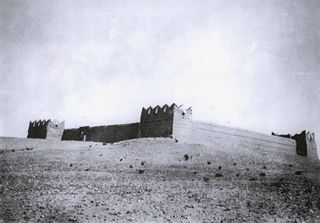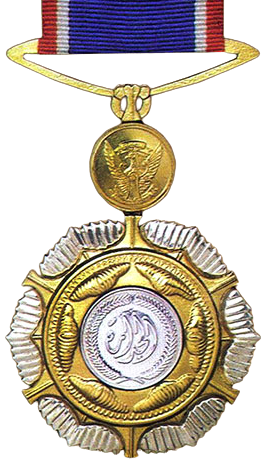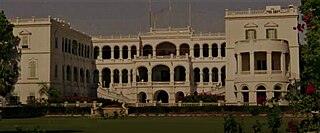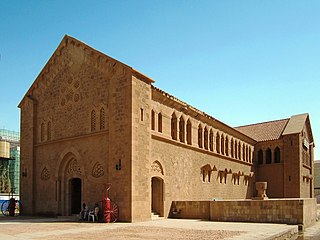
Khartoum or Khartum is the capital of Sudan. With a population of 6,344,348, Khartoum's metropolitan area is the largest in Sudan.

Sudan, officially the Republic of the Sudan, is a country in Northeast Africa. It borders the Central African Republic to the southwest, Chad to the west, Egypt to the north, Eritrea to the northeast, Ethiopia to the southeast, Libya to the northwest, South Sudan to the south, and the Red Sea. It has a population of 45.7 million people as of 2022 and occupies 1,886,068 square kilometres, making it Africa's third-largest country by area and the third-largest by area in the Arab League. It was the largest country by area in Africa and the Arab League until the secession of South Sudan in 2011; since then both titles have been held by Algeria. Its capital city is Khartoum, and its most populous city is Omdurman.

River Nile State is one of the 18 wilayat or states of Sudan. It has an area of 122,123 km² (47,152 mi²) and an estimated population of 1,511,442. It is made up of seven localities.

Shibin El Kom is a city in Egypt's Nile Delta, and the capital of the Monufia Governorate.

The politics of South Sudan concern the system of government in the Republic of South Sudan, a country in East Africa, and the people, organizations, and events involved in it.

The vice president of Sudan is the second highest political position obtainable in Sudan. Currently there is a provision for one de facto vice president, deputy chairman of the Transitional Sovereignty Council, who is appointed by the chairman of the council. Historically either the first or the second vice president was from Southern Sudan. From 2011 until the abolition of the post in 2019, the second vice president was from Darfur.

El Ksar is a town and commune in the Gafsa Governorate, Tunisia. As of 2004 it had a population of 29,617.
The National Records Office of Sudan, located in Khartoum, serves as the National Archives of Sudan. It holds 20 million documents and 13,000 volumes about the history of Sudan since 1870.

The Kuwait Red Fort, or Red Palace, is a historic palace and museum that lies about 32 kilometres west of Kuwait City in Al-Jahra.
Khirbet al-Qasr is a Syrian village located in the Hirbnafsah Subdistrict in Hama District. According to the Syria Central Bureau of Statistics (CBS), Khirbet al-Qasr had a population of 1,007 in the 2004 census.

Photography in Sudan refers to both historical as well as to contemporary photographs taken in the cultural history of today's Republic of the Sudan. This includes the former territory of present-day South Sudan, as well as what was once Anglo-Egyptian Sudan, and some of the oldest photographs from the 1860s, taken during the Turkish-Egyptian rule (Turkiyya). As in other countries, the growing importance of photography for mass media like newspapers, as well as for amateur photographers has led to a wider photographic documentation and use of photographs in Sudan during the 20th century and beyond. In the 21st century, photography in Sudan has undergone important changes, mainly due to digital photography and distribution through social media and the Internet.

The visual arts of Sudan encompass the historical and contemporary production of objects made by the inhabitants of today's Republic of the Sudan and specific to their respective cultures. This encompasses objects from cultural traditions of the region in North-East Africa historically referred to as the Sudan, including the southern regions that became independent as South Sudan in 2011.
List of the Orders, decorations and medals of Sudan.

The Collar of Honour is a state decoration of Sudan established in 1956 after Sudan independence. The collar is awarded to the Head of state of Sudan and foreign countries.

The Order of Merit or Order of Distinction is a state decoration of Sudan established on 16 November 1961 during Ibrahim Abboud's military government. It is given to government officials for long service and performance with honesty, devotion, and excellent character. These officials might be either Sudanese or foreigners. Order have gold silver and bronze classes. It had an associated medal.

The Sudanese Republican Palace complex is the official residence of the President of Sudan, located in the capital city of Khartoum. It mainly consists of the Old Republican Palace built in 1830 and the New Republican Palace built in 2015. The Republican Palace has historical and cultural significance in Sudan. The palace is not open to the public, but there is a museum located behind it that visitors can explore.

The Republican Palace Museum is an important museum in Khartoum, Sudan, and contains historical collections dating back to Turco-Egyptian Sudan. The museum is part of the Republican Palace complex, the seat of government in Sudan during successive periods of modern Sudan's history. The museum was a cathedral that was opened in 1912 and closed in 1971 to be repurposed and opened to the public as a museum on 31 December 1999.

The Third Sudanese Sovereignty Council was the council that came after general parliamentary elections in 1965, the third in the history of Sudan, as it replaced the Second Sudanese Sovereignty Council, which was managing the country’s affairs for a transitional period after the overthrow of the rule of Lieutenant General Ibrahim Abboud. The Third Sovereignty Council consisted of five members, and its members were amended twice. The Chairman of the Sovereignty Council was Ismail al-Azhari. The Council was dissolved after Lieutenant General Jaafar al-Numeiri's 1969 coup against power, who in turn formed the Revolutionary Command Council, which replaced the Sovereignty Council.



















